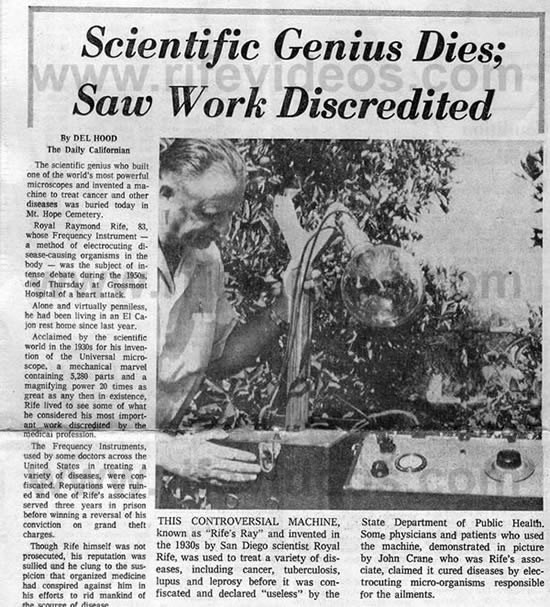Scientific Genius Dies; Saw Work Discredited |
The Daily Californian
Scientific Genius Dies; Saw Work Discredited
By DEL HOOD
August 1971
The scientific genius who built one of the world's most powerful microscopes and invented a machine to treat cancer and other diseases was buried today in Mt. Hope Cemetery.
Royal Raymond Rife, 83, whose Frequency instrument - a method of electrocuting disease causing organisms in the body - was the subject of intense debate during the 1950s, died Thursday at Grossmont Hospital of a heart attack.
Alone and virtually penniless, he had been living in an EI Cajon rest home since last year.
Acclaimed by the scientific world in the 1930s for his invention of the Universal microscope, a mechanical marvel containing 5,280 parts and a magnifying power 20 times as great as any then in existence, Rife lived to see some of what he considered his most import work discredited by the medical profession.
The Frequency Instruments, used by some doctors across the United States in treating a variety of diseases, were confiscated. Reputations were ruined and one of Rife's associates served three years in prison before winning a reversal of his conviction on grand theft charges.
Though Rife himself was not prosecuted, his reputation was sullied and he clung to the suspicion that organized medicine had conspired against him in his efforts to rid mankind of the scourge of disease.
"Having spent every dime I earned in my research for the benefit of mankind, I have ended up as a pauper, but I achieved die impossible and would do it again," Rife said in an affidavit filed at the time his friend and associate, John Crane, was appealing his conviction.
He accused die American Medical Assn. of rejecting his electronic therapy discoveries and implied the organization had "brainwashed and intimidated" his colleagues as well as "feloniously censored" the publication of his work.
"I certify that the AAA [AMA] and the Department of Public Health have declared war on Rife's Virus Microscope Institute," said the affidavit signed Feb. 7, 1967.
Rife built his microscope, one of five he invented, so he could actually see disease viruses and observe their activity, a triumph which astounded scientists at the time.
From his observations, Rife developed the theory that every micro-organism has a "mortal oscillatory rate" - a point at which it will shatter or break apart when bombarded by sound waves.
He had conceived the idea of electronic therapy as early as 1922, but it was not until 1934 in the Ellen Scripps home near La Jolla that he was ready to demonstrate “Rife’s Ray.”
Sixteen patients with incurable diseases were treated by physicians with Rife’s Ray in a clinical test of the machine supervised by Dr. Milbank Johnson of Los Angeles.
The claim was made that 14 of the 16 patients were pronounced "clinically cured" by the medical staff within 70 days and the remaining two patients were discharged after three months of treatment.
In the next 20 years, Rite perfected his machine - later to be called the Frequency Instrument - and about 100 ofthem were in use by physicians in various parts of the world.
Affidavits are on file in the courts from patients who claim they were cured of cancer, butterfly lupus - a skin aliment - and other diseases after treatment with the Frequency Instrument.
Scientists and physicians also claimed success with Rife's invention. One of his closest collaborators was Dr. Arthur Kendall, professor of bacteriology at Northwestern University Medical School, who wrote that he had observed successful treatment of a tumor on a man's cheek.
E. L. Walker of the George Williams Hooper Foundation, an early-day cancer research organization, hailed the device for its effectiveness against typhoid organisms.
"If the ray should prove equally efficient in killing other pathogenic micro-organisms," he wrote to Johnson. "It would be the greatest discovery in the history of therapeutic medicine." Another devout believer in electronic therapy was Dr. Robert Stafford of Dayton, Ohio, who said the machine had cured some of his patients and relieved others of distress.
But when the State Department of Public Health held its hearing in 1958 to determine if the Frequency Instrument should be approved as a treatment device, all claims in its behalf were rejected.
The hearing board said clinical research "provided no reasonable substantiated evidence or the effectiveness of the Frequency Instrument, consisting primarily of unverified testimonials of physicians and patients. . ."
It concluded that the Frequency Instrument was “a useless device."
Though he held no medical degree, Rife studied optics tor seven years in New York and
Heidelberg, Germany, and performed more man 50,000 experiments in his research laboratory. He was always referred to in medical journals as "Dr." Rife, believed to be a title conferred by an honorary degree.
His interests extended in many directions. He was a talented musician, an ardent sportsman and at the time of his death still held a speedboat racing title.
Embittered by his treatment from the medical profession, Rife turned to religion after a bout with alcohol and became a member or the Baha’i Faith.
Before his death be offered some of his thoughts to a friend and told her: "The most important thing I ever did was build a microscope." |

